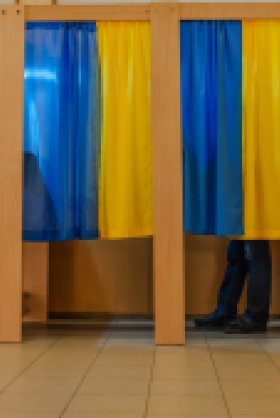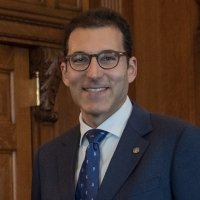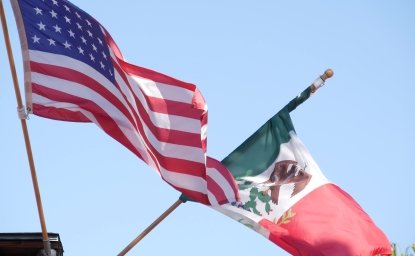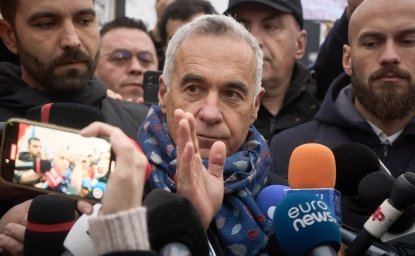Kennan Cable No. 30: Democracy in Ukraine: Are We There Yet?


Introduction
More than a quarter century ago, the Ukrainian people made a historic choice in favor of independence, democracy, and the free market. Their vision of a fully sovereign, democratic, and prosperous state has been only partially fulfilled. While Ukraine is a clearly established polity with internationally recognized sovereignty, it is nonetheless hampered in its democratic and free market development by endemic corruption, retrograde political cycles, and aggression by its powerful neighbor Russia.
After the dissolution of the Soviet Union, Ukraine emerged as a highly pluralistic but unstable democracy. Through the 1990s, the country’s political system developed along two parallel paths, combining a liberal democratic façade with post-Soviet oligarch-controlled distribution of power and resources. The contradictions between these two dimensions of Ukraine’s politics yielded two revolutionary cycles, spanning roughly 1992–2004 and 2005–2014. During each of these cycles, a period of popularly supported democratic reforms was soon displaced by simulated democracy, driven essentially by oligarchic competition and then, later, by authoritarian consolidation, resulting in civic protests and eventual regime change, resetting the cycle.
Ukraine’s transition from Soviet republic to fully democratic state has been inhibited by these cycles. It is yet to be determined whether Ukraine’s democratic development has been set on a sustainable path in the wake of the 2014 Euromaidan, the process of closer political and economic association with the European Union (EU), and the war in Donbas. There are many reasons to hope this is now the case, but there is also cause for serious concern about the sustainability of current reform efforts and democratic politics.
Development of Ukraine’s Constitutional Order
Post-Soviet Ukraine’s constitutional order has been subject to several key dichotomies: presidentialism versus parliamentarianism, centralization of power versus local self-governance, and institutionalized democracy versus persistent clan politics.
Competition between the president and parliament began from the earliest post-Soviet period. Presidents Leonid Kravchuk (1991–1994) and Leonid Kuchma (1994–2005) both battled with the Verkhovna Rada for power, resulting in a five-year constitution drafting process that finally produced a new semi-presidential constitution in June 1996. This document elevated the president over the entire executive branch, including the prime minister and cabinet, and a network of regional (oblast’) governors appointed by the president. However, the Rada itself retained a high level of independence, and, with the judiciary, helped to bring the system into relative balance.
Kuchma tried to constrain the Rada’s independence by proposing a referendum in 2000 to split the legislative body into two chambers. Although a majority of Ukrainians voted for Kuchma’s “reform,” the Rada blocked implementation. [i] The constitution of 2004, a reaction to the Orange Revolution, readjusted the balance once more, making Ukraine a “parliamentary-presidential” republic. While the president retained considerable power and influence, especially in the security and diplomatic spheres, the ruling coalition in the Rada was awarded control over the Cabinet of Ministers and thus of the bulk of executive branch competencies.
When Viktor Yanukovych was elected president in 2010, he used informal and corrupt influence to secure control over Ukraine’s Constitutional Court, and with its support rolled back the 2004 constitutional changes, restoring the previous semi-presidential system with enhanced powers for himself.
The tables turned once again following the Euromaidan protests, which became known as the Revolution of Dignity, in the winter of 2013–14. After Yanukovych fled the country, the Rada again reinstated the 2004 Constitution, giving itself increased authority.[ii] According to its constitution, Ukraine today is once more a parliamentary-presidential republic, but the real power of the president goes far beyond constitutional limits.[iii]
One of the first victims of the recurring battles between presidents and parliaments in Ukraine was local self-governance. In the 1990s, local councils steadily lost power to the central government in Kyiv.[iv] By 2002, the president, the cabinet, and the Rada had assumed so much authority from local governments that Kuchma decided to begin limited decentralization reforms to reduce the burden on his government of solving every local problem and need. Yet the decentralization was never implemented, and the erosion of local communities’ authority continued up to the Yanukovych era.
The trend shifted in 2014. Under intense pressure from civil society, new voices in the Rada, and outside actors like the EU, Kyiv launched a program of decentralization reforms.[v] By 2017, local governments had more responsibility for local services, bigger budgets, and a greater role in serving the needs of their constituents. However, the national government remains much stronger in decision-making on regional development matters than regional officials. The president retains the capacity to appoint heads of local governments at the oblast’ and rayon levels, and (if current draft reforms are implemented) plans call for the president to effectively control all decisions by local councils.[vi]
A third factor is the rivalry between public institutions and financial-political groups, which can be termed oligarchic “clans.” Lacking strong institutions in the immediate post-Soviet period, emerging elites and the populations and enterprises that depended on them formed patron-client networks to solve collective and individual problems.[vii],[viii] Clans were often organized as regional groups, and as they grew, they competed with one another at the national level for control of the government, parliament, and state-owned monopolies.[ix] The role of the president became that of arbiter among the clans. The victorious groups would gain control of the presidential administration, which in turn developed into a shadow government (displacing the Cabinet of Ministers) in which major clans, like those of Dniepropetrovsk and Donetsk, settled disputes and shared power.[x]
As one prominent clan representative put it, “we are four oligarchic groups, each of which is stronger than the state, and we all hate one another so we cannot agree on anything but balance one another. Therefore, Ukraine is bound to be a democracy.” [xi] Of course, rather than a fully democratic system, this clan competition gave rise to something closer to hybrid democracy, or a system of oligarchic pluralism.
All three of these forces in Ukraine’s politics exerted pressures on the constitutional order that retarded Ukraine’s democratic transition over the quarter century since 1991. Post-Soviet presidentialism concentrated so much power in one person that it inherently threatened civil rights and political representation. Excessive centralization accelerated the decay of many local community institutions. Meanwhile, patron-client networks delivered benefits to some in society, but did so at the cost of public institutions. These networks emerged as the main drivers of Ukraine’s systemic corruption.[xii]
Five Phases of Electoral Development
Not surprisingly, the clashing forces built into Ukraine’s constitutional order eroded both the strength of political parties and the trust of ordinary citizens in the electoral process. This evolution developed over five phases.
In the first phase (1992–1998), Ukraine established direct and majoritarian elections, but the absence of strong political parties left the main stage to the old Communist Party networks and emerging regional clans. The Communist Party remained a strong organized parliamentary force until 2014. Its offspring, the more moderate Socialist Party, was also influential from the 1990s to the mid-2000s. As the registry of the Ministry of Justice shows, there were over 40 other registered parties, but they lacked stable structure and clear ideology.[xiii]
During the second phase (1999–2004), the ruling clans initially supported the creation of a “vertical of power” concentrating authority in the presidency. They then split into pro- and anti-presidential factions. During this period, the model of a “party of power” was tested in Ukraine.[xiv] Several parties were used by president Kuchma and his administration in this role between 1998 and 2004. However, Kuchma’s opposition also attempted to unify within the “Ukraine without Kuchma” movement.[xv] By 2004, there were over 80 parties registered in Ukraine.[xvi]
In 2002 the Rada was elected through a mixed electoral system of proportional lists and single-mandate districts.[xvii] As a result, the anti-Kuchma, pro-European groups secured a majority of proportional seats. However, Kuchma’s supporters held a majority of seats overall thanks to victories in the single-mandate districts, where candidates relied on the president’s “administrative resources” and were more vulnerable to pressure from state agencies.
The third phase (2005–2009) was a period of greater party competition, with the Rada playing a growing role in national political life in the wake of the 2004 constitutional reform. During this period, political parties twice (in 2006[xviii] and 2007[xix]) competed in purely proportional parliamentary elections. The Party of Regions represented primarily the urbanized industrial elites in the southeast, with several Donbas clans joined together under the leadership of then-Donetsk Governor Viktor Yanukovych.[xx] The party had strong ties with southeastern and central Ukrainian local and oblast councils, religious networks, industrial corporations, small and medium enterprises, regional media, and with Moscow, Brussels, and Washington. Yushchenko’s Our Ukraine[xxi] and Tymoshenko’s BYuT/Fatherland [xxii] parties competed with one another for support in the northwestern and central regions of the country. These parties coopted local elites into their networks, and competed for stronger ties in EU capitals and in Washington.
Electoral competition in the third phase peaked at the time of the economic crisis of 2008–09, when Ukrainian society suffered a kind of democratic fatigue, and entered the fourth phase (2010–2013). In the run-off round of the 2010 presidential elections, Viktor Yanukovych and Yulia Tymoshenko represented two different geopolitical and regional orientations, but both offered authoritarian-leaning political agendas.[xxiii] Although Yanukovych won with only a slim majority, he quickly consolidated power, managing to re-establish Kuchma’s presidential model of government by 2010[xxiv] and to win a majority in 90 percent of the regional councils during that year’s local elections.[xxv]
In 2012 parliamentary elections were once more conducted under the mixed model of proportional and single-mandate seats.[xxvi] Though the Party of Regions won only 30 percent of seats nationwide, Yanukovych secured a majority in the Rada by banding together with single-mandate representatives from a few minor parties, including the Communists. He imprisoned his most popular opposition politicians, including Tymoshenko and Yurii Lutsenko, deepening the East-West electoral divide, and contributing to the rise of the far right Freedom Party, which entered the Rada in 2012.
The current fifth period (since 2014) has witnessed a “reset” of the party system following the Euromaidan protests, which were genuinely led from below and in which traditional parties played a very limited role. Candidates in the 2014 presidential and parliamentary elections were mostly not from among the most influential groups in pre-Euromaidan Ukraine. The Party of Regions was thoroughly destroyed, and its constituencies were deconsolidated in the southeast. The Fatherland Party was split into factions supporting Tymoshenko and Arseniy Yatseniuk, who became prime minister. The elected president, Petro Poroshenko, and his supporter, Kyiv Mayor Vitaly Klitchko, formed a dominant block with the parties Solidarity and Strike. Two new political groups, Self-Reliance and the Radical Party, found themselves among the winners of elections but without a clear allegiance.[xxvii]
A key feature of the current period is the sidelining of the once-dominant southeastern electorate. Ukraine’s electoral ecology has changed with the loss of all Crimean voters and a majority of voters in Donbas, with remaining elites and voters in the South-East distracted by the ongoing war. Galician and other nationalist groups have gained control over ideological institutions (i.e. the Ministry of Education and Science and the Institute of National Memory) to promote their agenda.
Despite requirements in the EU-Ukraine Association Agreement, Ukraine’s electoral system remains outside of the reform process so far. The Central Electoral Commission (CEC) is under pressure from the presidential administration: criminal investigations were launched against its chair, while 13 of 15 members have expired mandates yet remain in their positions. Ukraine’s electoral system itself is the object of an ongoing battle among the president and the ruling parties, the parliamentary opposition, and the remaining oligarchic clans.
Two Revolutionary Cycles in Ukrainian Politics
Ukraine has undergone two revolutionary cycles, each resulting in civic protests and a collapse of the ruling power. The Orange Revolution was provoked by fraudulent vote counting in the 2004 presidential elections. Hundreds of thousands supporting opposition candidate Viktor Yushchenko peacefully protested for weeks, forcing President Kuchma and Prime Minster Yanukovych to agree to a second vote. It was after this decision that the Rada moved to amend the 1996 constitution and introduced the parliamentary-presidential model to limit Yushchenko’s future power.
The second civic revolution also began with peaceful protests provoked by the refusal of then-President Yanukovych to sign the EU-Ukraine Association Agreement in November 2013. However, this time the government and radical opposition provoked a spiral of violence that resulted in bloody street fighting during January 2014, and even mass murder of Ukrainians in February 2014. President Yanukovych fled to Russia, while the Rada restored the 2004 Constitution and voted in a temporary president and cabinet. Soon after, Russia invaded and annexed Crimea, and Russia-backed secessionists attempted to split Ukraine’s southeastern oblasts from the country.[xxviii]
In 2005, Yushchenko’s winning Orange team was eager to communicate with the opposition, which permitted a smooth re-consolidation of Ukrainian elites in 2005–06. However, after Yanukovych’s victory in 2010, the division between ruling groups and the opposition deepened, culminating in the imprisonment of Tymoshenko and Lutsenko.[xxix] Accordingly, when these and other figures came back to politics in 2014, the Communist Party and Party of Regions were effectively banned. The Opposition Block, representing the interests of the former Communist and Regions Party, is seen as illegitimate and not permitted to chair any parliamentary committees.[xxx]
Facing a Russian invasion and Russian-backed separatism in the southeast, the five parties forming the ruling coalition in 2014–16 were not eager to discuss reforms with the largely Russian-speaking and southeastern-based opposition.[xxxi] In April–May 2016, the ruling coalition unraveled, and the president’s supporters have since then excluded both old and new opposition groups from policy consultations and decision-making processes. [xxxii]
With a severely eroded election system and sidelined opposition parliamentary groups, the Rada’s influence is waning. As a result, some non-parliamentary radical groups, including veterans groups and the extreme right, have gained visibility. [xxxiii] Despite low support in national polls, their engagement in decision-making at local levels is growing, and will likely influence national politics in the coming years.
Impacts of Politics on Prosperity, Social Security, and Corruption
Ukraine’s hybrid politics and resulting political cycles have had important impacts on prosperity, social security, and basic living conditions for ordinary Ukrainians. After losing nearly a quarter of GDP during the deep socio-economic crisis of the 1990s, Ukraine benefitted from some successful liberalization and privatization reforms. By the late 2000s, inflation was under control and renewed growth and investment had helped push output to levels not seen since before the Soviet collapse. Yet these periods of economic growth and social stability fell victim to political and geo-economic cycles as well, with losses of 15 percent of GDP in 2008–09,[xxxiv] and 14 percent of GDP in 2013–16.[xxxv] In 2017 the Ukrainian economy is ranked 166th in terms of economic freedom.[xxxvi]
Not surprisingly, citizens continue to have very little trust toward government in Ukraine. Since mid-2008, trust in courts, the parliament, the cabinet, and the president has been at critically low levels. Today, the most trusted (over 50 percent) institutions include the church, volunteer fighters, and the national army, while the least trusted (under 10 percent) are the government, parliament, and the courts.[xxxvii] Over 70 percent of Ukrainians believe that Ukraine is heading in the wrong direction.[xxxviii]
A major factor driving citizens’ distrust of government is, of course, continued corruption. Ukraine scored 29 on the 2016 Corruption Perceptions Index, which rates countries with numbers from 100 (very clean) to 0 (very corrupt). Ukraine’s average score from 1998 to 2016 was 24.58 points.[xxxix] Ukraine’s 2016 result remains disturbingly poor.
Post-revolutionary politics have had a mixed impact on corruption. In 2005, Viktor Yushchenko fired over 30,000 public servants as part of his anticorruption reform. Nonetheless, the public sector’s efficiency declined during the Orange period. [xl],[xli] After the Euromaidan, the lustration process (the purge of government officials based on moral or political grounds) also yielded contradictory results, including diminishing government performance.[xlii] For example, even in the well-regarded new patrol police, there is a lack of experienced criminal investigators, because those who served in the previous police force (militsiya) during the Yanukovych period are blocked. Newly trained investigators, lacking experience, have been unable to deliver results in even the most high-profile murder cases.[xliii]
Under considerable pressure from the post-Maidan civil society activists and Ukraine’s Western supporters, the government has introduced some key anti-corruption policies and created agencies to fulfill them. In 2015–16 two new institutions were created to combat corruption, through prosecution (National Anticorruption Bureau, NABU) and prevention (National Agency for Prevention of Corruption, NAPC). The NABU has launched several new investigations against close allies of President Poroshenko and former Prime Minister Yatseniuk.[xliv] Meanwhile, the NAPC established a new e-declaration system for officials to declare assets.[xlv] The e-declaration system was launched in 2016, and by April 2017, over 1 million officials had submitted their e-declarations.[xlvi] These steps hold out the promise for a considerable improvement in governance, use of public resources, and moderating elites’ behavior.
However, Poroshenko and other powerful actors continue to apply huge pressure against these new anti-corruption bodies, and their survival likely depends on continued support from the West.[xlvii]
The lack of transparency and effectiveness of government institutions in Ukraine has been one of the major consequences of the country’s political cycles. Low citizen confidence and high corruption perceptions are merely a reflection of this reality. Although improvement is visible and measurable for now, results from the reforms have not yet met the expectations set by Ukrainian activists and Ukraine’s international supporters.
Role of Civil Society in Democratic Development
In an atmosphere with elements of wartime as well as political and economic crisis, the Ukrainian population nonetheless continues to cherish the ideals of democratic governance and state sovereignty championed by civil society in the Euromaidan.[xlviii] Despite some tensions among ethno-linguistic and ideological blocs, Ukrainian society remains relatively united, and its civic activists are taking part in reforms and crisis response.[xlix],[l] Yet it is troubling that not all Ukrainians enjoy unfettered political freedoms and civil rights, and the country is for that reason considered only “partially free” by international watchdogs.[li]
The Ukrainian media space remains an echo of the oligarchic pluralism of previous periods in Ukraine’s national life. Major broadcast channels belong to different clans and support rival political parties. On the one hand, this preserves media pluralism; on the other hand, this does not enhance the quality of journalism and society’s trust in the media.[lii] For example, the four biggest TV channels, which are Ukrainians’ major sources of information about politics, each belong to different owners, some of whom are in opposition to President Poroshenko.
There have been sporadic new media projects in Ukraine, such as Hromadske TV (since 2013) and UkrLife TV (since 2014). The reform of state-owned public television is also slowly being implemented.[liii]
Civil society organizations (CSO) have been politically influential since at least 2004, when CSOs took an active part in the protests that led to regime change.[liv] The CSO sector has also been very active in advocating for deeper and faster democratic reforms. The Reanimation Package of Reforms is an example of a coalition of CSOs that not only advocates for reforms, but even participates in the drafting of reform legislation and key documents together with the government and Rada members in over 10 different areas.[lv] Although this group has been criticized for its over-dependence on outside grant funding and its focus on international rather than domestic opinion, it remains a key example of activist civil society.[lvi]
After Yanukovych’s fall in February 2014, civic organizations were the first to fill the power vacuum in the defense, security, and police sectors, as well as many others.[lvii] Volunteer battalions were the first to defend Ukraine against the Russian invasion of Crimea, the Russian-backed secessionist war in Donbas, and attempts to destabilize other regions of the country. However, later many of these organizations were reluctant to cede authority to official state institutions. Now, some have joined forces[lviii] to promote far-right political agendas and/or to call for direct political action.[lix]
The church also plays a significant role in civic and political activism in Ukraine. Different political clans and groups allied with different religious organizations. For example, Viktor Yushchenko supported the Ukrainian Orthodox Church (Kyiv Patriarchate), which he hoped could consolidate the Ukrainian Autocephalous Church and Ukrainian Orthodox churches under its authority. Viktor Yanukovych backed the Moscow Patriarchate, and regional politicians in the west of Ukraine have had closer ties with the Ukrainian Greek Catholic Church. In return, these churches have supported their candidates during elections.
Ukrainian Pluralism and Democratic Development
Ukraine is a culturally, ethnically, linguistically, and religiously heterogeneous society. The (in)famous divide between eastern and western Ukraine is above all just a function of electoral coalitions that represent clans and interests concentrated in the southeastern and northwestern parts of the country. In cultural, linguistic, and religious terms Ukraine is much more diverse than this binary juxtaposition suggests.,[lx]
Three major orthodox churches, the Greek Catholic Church, the Roman Catholic Church, many protestant denominations, Muslims, Buddhists, Jews, and many other religious groups worship and organize freely in Ukraine. Besides large Ukrainian- and Russian-speaking populations, there are communities speaking Crimean Tatar, Hungarian, Romanian, and other minority languages. For more than a decade after 1991, Ukraine followed the principle of uniform respect and tolerance for this diversity.
Ethno-linguistic and regional identities were strongly politicized during the presidential election of 2004. From that time through the elections of 2014, political parties adopted the habit of using the “language issue” and regional differences to mobilize their electorates, a practice which has, of course, eroded social cohesion.[lxi]
Russia has also manipulated the language issue from the outside. In the spring of 2014, Russian-backed secessionists argued that Russian language rights could be protected only by creating a separate state for Russian speakers in the southeastern oblasts of Ukraine (so-called “Novorossia”).[lxii],[lxiii] Nevertheless, in the war to oppose that separatist movement, both Ukrainian and Russian speaking populations mobilized in large numbers. In fact, all language groups in Ukraine were stable in their support for Ukraine’s independence and sovereignty across all regions.[lxiv]
Conversely, some governmental ideological and language policies continue to erode social cohesion along language and regional lines. The implementation of the so called “Decommunization Laws” in 2015 has added to distrust between the national center and local communities.[lxv],[lxvi] Also, language quotas[lxvii] in Ukrainian media and attempts to ban Russian language social networks may have increased tensions between Ukrainian and Russian speakers.[lxviii] Russophone schools and schools with minority languages could be closed, according to the recently approved law on education.[lxix] All these policies diverge from the civil inclusive approach to nation-building that Ukraine was previously known for.
The cultural challenge is most acute for the populations of occupied Crimea and Donbas. Most information and trade ties with these regions have been severed, and there has accordingly been a dramatic decline in shared identities between communities on opposite sides of the Russian occupation.[lxx] However, 80 percent of Ukrainians remain convinced that eastern Donbas should be a part of Ukraine. Ukraine must therefore consider how to socially reintegrate this population.[lxxi]
External Influences and the Fate of Democracy in Ukraine
For over 20 years, Ukraine was pulled between two rival geopolitical processes: European integration and Eurasian re-integration. Ukraine typically adopted a “multi-vector” foreign policy in response, that aimed to benefit from both integration processes and to limit external influences by balancing Moscow, Washington, and Brussels with one another.[lxxii] However, each Ukrainian administration interpreted the strategy with a different tone: Yushchenko’s administration was pro-Western, while the Yanukovych government leaned toward the Kremlin.
Since the Euromaidan, which was triggered by a crisis point in European versus Eurasian integration, and the subsequent Russian invasion of Crimea and Donbas, the Ukrainian government has severed ties with Russia. By 2017, Ukrainian-Russian ties fell to a historic low, with tight controls on commerce, media/broadcasting, and travel. Today, there is very little, if any, direct influence from Moscow on Ukrainian internal politics.[lxxiii] Meanwhile, Moscow’s own Ukraine policy is aimed at making it impossible for Ukraine to join NATO, at increasing the legitimacy of Crimean annexation, and at supporting the break-away territories of eastern Donbas.[lxxiv] Russia now operates as an outsider to Ukrainian politics, not an inside player.
Conversely, Western influence in Ukrainian politics has only grown since 2014. The EU-Ukraine Association Agreement has set the major goals for reforms, while the IMF continues to administer a special $17 billion credit program in exchange for progress on these reforms.[lxxv] Yet as Kyiv has become less dependent on IMF support[lxxvi] and internal political competition in Ukraine has intensified, the speed of reforms has slowed and the West has taken more of a backseat in Ukrainian politics.[lxxvii]
Conclusion
Ukraine has not yet found balance between positive and negative trends in its democratic development. The positive trends flow from the EU-Ukraine Association Agreement, the modestly successful reform agenda, and the support of Western partners.[lxxviii] The 2016 referendum in the Netherlands on EU-Ukraine Association Agreement and the denial of a foreseeable EU membership have only slightly diminished these positive impacts.[lxxix] Likewise, attempts by Ukrainian elites to reverse some reforms in 2016–17 have thus far been successfully countered by coalitions between civil society, reformist politicians, and Western diplomatic services in Kyiv (e.g., the preservation of NABU’s autonomy).[lxxx]
On the other hand, Russia’s invasion and annexation of Crimea and its continuing support for violent separatists in Donbas have created much more challenging conditions for Ukrainian democracy. As a result of these Russian interventions, the military and security establishment play a far greater role in Ukrainian government, and some prominent civic movements draw inspiration and credibility from war-related ideologies. These new factors increase the political weight of the president as military commander-in-chief, and introduce risks of even more radical authoritarian tendencies on the part of political forces that are now entirely outside the government.
Economic prosperity has been subordinated to security concerns (as the recent blockades of Donbas showed). Voters continue to reject most state institutions as untrustworthy and corrupt.[lxxxi] The result is that politics are highly fluid, institutions are weak, and clans dominate political competition, with some indications of the pre-revolutionary cycles witnessed before in the early 2000s and 2010s.
All in all, Ukrainian democracy has come a long way from its earliest post-1991 manifestations. It now boasts a vibrant civil society, well-organized and powerful political parties, and a diverse pluralism of domestic, social, and geopolitical influences. Yet Ukraine’s democracy is also hostage to the ongoing war with Russia and the country’s continuing socio-economic crisis. The future depends on whether the war can be brought to a peaceful end, national reconciliation can be launched, and ordinary Ukrainians can begin to benefit from the many reforms now underway. With these three foundational tasks achieved, Ukraine’s democracy will be back on track.
The opinions expressed in this article are those solely of the authors.
[i] Georgii Kasyanov, Ukraina 1991-2007: Ocherki noveishei istorii (Kyiv: Nash chas, 2008).
[ii] “Rada Reinstates Constitution of 2004,” Ukrinform, 22 February 2014, https://www.ukrinform.net/rubric-polytics/1621511-19949a9b6925e23e91801b4eebd1e711.html.
[iii] Balasz Jarabik and Mikhail Minakov, “The Consolidation of Power in Ukraine: What it Means for the West,” Carnegie Endowment for International Peace, 19 September 2016, http://carnegieendowment.org/2016/09/19/consolidation-of-power-in-ukraine-what-it-means-for-west-pub-64623.
[iv] The Aston Centre for Europe–Aston University, Local and Regional Government in Ukraine and the Development of Cooperation Between Ukraine and the EU (European Union, 2011), http://cor.europa.eu/en/documentation/studies/Documents/local-regional-government-ukraine.pdf. doi: 10.2863/59575.
[v] Balazs Jarabik and Yulia Yesmukhanova, “Ukraine’s Slow Struggle for Decentralization,” Carnegie Endowment for International Peace, 8 March 2017, http://carnegieendowment.org/2017/03/08/ukraine-s-slow-struggle-for-decentralization-pub-68219.
[vi] Yuriy Hanushchak Oleksii Sydorchuk, and Andreas Umland, “Ukraine’s Most Underreported Reform,” New Eastern Europe, 13 April 2017, http://neweasterneurope.eu/2017/04/13/ukraine-s-most-underreported-reform-decentralisation-after-the-euromaidan-revolution/.
[vii] Anders Åslund, How Ukraine Became a Market Economy and Democracy (Washington, DC: Peterson Institute for International Economics, 2009).
[viii] H. E. Hale, Patronal Politics: Eurasian Regime Dynamics in Comparative Perspective (Washington, DC: George Washington University Press, 2014).
[ix] Rosaria Puglisi, “The Rise of the Ukrainian Oligarchs,” Democratization 10, no. 3 (2003): 99–123.
[x] Mikhail Minakov, “A Decisive Turn? Risks for Ukrainian Democracy After the Euromaidan,” Carnegie Endowment for International Peace, 3 February 2016, http://carnegieendowment.org/2016/02/03/decisive-turn-risks-for-ukrainian-democracy-after-euromaidan-pub-62641.
[xi] Anders Åslund, How Ukraine Became a Market Economy and Democracy (New York: Columbia University Press, 2009).
[xii] Alexander J. Motyl, “Ukraine’s Orange Blues: Fighting Corruption in Ukraine,” World Affairs, 1 June 2015, http://www.worldaffairsjournal.org/blog/alexander-j-motyl/fighting-corruption-ukraine.
[xiii] «Політичні партії,» Департамент Державної реєстрації та Нотаріату, accessed 8 November 2017, http://ddr.minjust.gov.ua/uk/ca9c78cf6b6ee6db5c05f0604acdbdec/politychni_partiyi/.
[xiv] Vadym Denysenko, “Ukraine’s First Party of Bureaucrats Could Not Keep Power,” День, 21 March 2000, https://day.kyiv.ua/en/article/close/ukraines-first-party-bureaucrats-could-not-keep-power.
[xv] Lydia Bailey, “Ukrainians Protest for Regime Change (Ukraine without Kuchma), 2000–2003,” Global Nonviolent Action Database, 2 September 2013.
[xvi] “Політичні партії,” Департамент Державної реєстрації та Нотаріату, accessed 8 November 2017, http://ddr.minjust.gov.ua/uk/ca9c78cf6b6ee6db5c05f0604acdbdec/politychni_partiyi/.
[xvii] “Ukraine,” Election Guide, 31 March 2002, http://www.electionguide.org/elections/id/1335/.
[xviii] “Ukraine,” Election Guide, 26 March 2006, http://www.electionguide.org/elections/id/1437/.
[xix] “Ukraine,” Election Guide, 30 September 2007, http://www.electionguide.org/elections/id/1484/.
[xx] Jordan Bryant and Michael Smeltzer, “Ukraine’s Party of Regions: Russian Nationalists or Champions of Ukraine’s Minorities?” The School of Russian and Asian Studies, 22 August 2013, http://www.sras.org/ukraine_party_of_regions_part_1.
[xxi] “Our Ukraine,” Encyclopaedia Britannica, accessed 8 November 2017, https://www.britannica.com/topic/Our-Ukraine.
[xxii] SRAS Students, “Yulia Tymoshenko and Batkivshchyna (Fatherland) Party,” Geohistory, 1 September 2013, http://geohistory.today/yulia-tymoshenko-batkivshchyna/.
[xxiii] “Ukraine,” Election Guide, 7 February 2010, http://www.electionguide.org/elections/id/2143/.
[xxiv] “Ukraine Court Boosts Powers of President Yanukovych,” BBC News, 1 October 2010, http://www.bbc.com/news/world-europe-11451447.
[xxv] Nico Lange, “Local Elections in Ukraine: Yanukovych’s Consolidation of Power,” Konrad-Adenauer-Stiftung, 9 November 2010, http://www.kas.de/ukraine/en/publications/21063/.
[xxvi] “Ukraine,” Election Guide, 28 October 2012, http://www.electionguide.org/elections/id/1641/.
[xxvii] Kostyantyn Fedorenko, Olena Rybiy, and Andreas Umland, “The Ukrainian Party System Before and After the 2013–2014 Euromaidan,” Europe-Asia Studies 68, no. 4 (2016): 609–630.
[xxviii] Yuriy Shveda and Joung Ho Park, “Ukraine's Revolution of Dignity: The Dynamics of Euromaidan,” Journal of Eurasian Studies 7, no. 1 (2016): 85–91.
[xxix] “Ukraine Lutsenko Arrest ‘Violated Rights,’ Says Court,” BBC News, 3 July 2012, http://www.bbc.com/news/world-europe-18692218.
[xxx] Mikhail Minakov, “A Decisive Turn? Risks for Ukrainian Democracy after the Euromaidan,” Carnegie Endowment for International Peace, 3 February 2016.
[xxxi] Ukraine Reform Monitor Team, “Ukraine Reform Monitor: April 2016,” Carnegie Endowment for International Peace, 28 April 2016, http://carnegieendowment.org/2016/04/28/ukraine-reform-monitor-april-2016-pub-63486.
[xxxii] David Stern, “Ukraine’s Governing Coalition Loses Majority,” Politico, 18 February 2016, https://www.politico.eu/article/ukraine-governing-coalition-collapses-loses-majority-political-crisis/.
[xxxiii] Veronika Pehe and Tom Rowley, “Nowadays, Everyone is a Potential Target in Ukraine,” Krytyka Polityczna and European Alternatives, 3 May 2017, http://politicalcritique.org/cee/ukraine/2017/ukraine-activism-attack/.
[xxxiv] C. W., “Why is Ukraine’s Economy in Such a Mess?” The Economist, 5 March 2014, https://www.economist.com/blogs/freeexchange/2014/03/ukraine-and-russia.
[xxxv] “Ukraine Economic Update—September 2016,” The World Bank, accessed 8 November 2017, http://www.worldbank.org/en/country/ukraine/publication/ukraine-economic-update-fall-2016.
[xxxvi] “Ukraine: 2017 Index of Economic Freedom,” The Heritage Foundation, accessed 8 November 2017, http://www.heritage.org/index/country/ukraine.
[xxxvii] Stanislav Zlenko, “Trust to Social Institutions,” 1 February 2017, Kyiv International Institute of Sociology, http://kiis.com.ua/?lang=eng&cat=reports&id=678&page=1.
[xxxviii] «Опитування IRI: Динамика Суспільно-Політичних Погядів в Україні», Рейтинг, 8 June 2017, http://ratinggroup.ua/research/ukraine/poll_iri_dinamika_obschestvenno-politicheskih_vzglyadov_v_ukraine.html.
[xxxix] “Ukraine Corruptions Index,” Trading Economics, accessed 8 November 2017, https://tradingeconomics.com/ukraine/corruption-index.
[xl] Anders Åslund, How Ukraine Became a Market Economy and Democracy (New York: Columbia University Press, 2009).
[xli] Касьянов, «Украина 1991–2007: очерки новейшей истории».
[xlii] Final Opinion on the Law on Government Cleansing (Lustration Law) of Ukraine, Opinion No. 788/2014, Venice Commission, Council of Europe, 19 June 2015, http://www.venice.coe.int/webforms/documents/default.aspx?pdffile=CDL-AD(2015)012-e.
[xliii] Tanya Cooper, “Ukraine: Who Killed Journalist Pavel Sheremet?” Human Rights Watch, 20 July 2017, https://www.hrw.org/news/2017/07/20/ukraine-who-killed-journalist-pavel-sheremet.
[xliv] Natalia Zinets and Pavel Polityuk, “Ukraine Makes Two High-Profile Detentions in Corruption Case,” Reuters, 21 April 2017, http://www.reuters.com/article/us-ukraine-corruption-arrests/ukraine-makes-two-high-profile-detentions-in-corruption-case-idUSKBN17N1AS?il=0.
[xlv] «Про Реєстр», Єдиний Державний Реєстр Декларацій, 8 November 2017, https://public.nazk.gov.ua.
[xlvi] “Democratic Governance, Human Rights and Civil Society Development,” accessed 8 November 2017, http://dhrp.org.ua/en/.
[xlvii] “Statement by the United States Embassy and the EU Delegation to Ukraine,” U.S. Embassy in Ukraine, 7 March 2017, https://ua.usembassy.gov/statement-united-states-embassy-eu-delegation-ukraine/.
[xlviii] “Ukraine Turns 25: Achievements and Defeats,” Kyiv International Institute of Sociology, 25 August 2016, http://www.kiis.com.ua/?lang=eng&cat=reports&id=643&page=3&t=3.
[xlix] Jack Losh, “Can Ukraine Win Over Pro-Russian Citizens in the East—And Finally End the War with Separatists?” Newsweek, 12 April 2017, http://www.newsweek.com/2017/04/21/ukraine-only-hope-east-may-building-homes-and-schools-582509.html.
[l] Oxana Shevel, “Decommunization in Post-Euromaidan Ukraine: Law and Practice,” Ponars Eurasia, January 2016, http://www.ponarseurasia.org/memo/decommunization-post-euromaidan-ukraine-law-and-practice.
[li] “Ukraine Profile,” Freedom House, accessed 8 November 2017, https://freedomhouse.org/report/freedom-world/2017/ukraine.
[lii] Halyna Budivska, “Research: Ukraine’s Media ‘Mistrusted, Biased Political Tool,’” European Journalism Observatory, 8 December 2015, http://en.ejo.ch/media-politics/12326.
[liii] Liuda Kornievych, “A Critical Moment for Public Broadcasting in Ukraine,” Hromadske International, 7 April 2017, https://en.hromadske.ua/posts/public-broadcasting-in-ukraine.
[liv] Beth Kerley, “Ukraine: Civil Society in the Balance,” Foreign Policy Research Institute, accessed 8 November 2017, https://www.fpri.org/article/2017/03/ukraine-civil-society-balance/.
[lv] Reanimation Package of Reforms, accessed 8 November 2017, http://rpr.org.ua/en/.
[lvi] Kateryna Smagliy, Kennan Cable No. 25: A Wake-up Call for Ukraine’s Civil Society (Washington, DC: Wilson Center, 24 August 2017), https://www.wilsoncenter.org/publication/kennan-cable-no25-wake-call-for-ukraines-civil-society.
[lvii] Mykhailo Minakov, “Changing Civil Society after Maidan—2014,” Academia.edu, 30 October 2014, https://www.academia.edu/9050237/Changing_Civil_Society_after_Maidan_-_2014.
[lviii] “Ukrainian Nationalists Join Forces: Svoboda, Right Sector and National Corps Sign Manifesto,” Unian, 16 March 2017, https://www.unian.info/politics/1826837-ukrainian-nationalists-join-forces-svoboda-right-sector-and-national-corps-sign-manifesto.html.
[lix] Jack Losh, “Ukraine Turns a Blind Eye to Ultrarightist Militia,” Washington Post, 13 February 2017, https://www.washingtonpost.com/world/europe/ukraine-turns-a-blind-eye-to-ultrarightist-militia/2017/02/12/dbf9ea3c-ecab-11e6-b4ff-ac2cf509efe5_story.html?utm_term=.f7256f209769.
[lx] Tanya Zaharchenko, “Polyphonic Dichotomies: Memory and Identity in Today's Ukraine,” Demokratizatsiya 21 no. 2 (2013): 241.
[lxi] Laada Bilaniuk, “Ideologies of Language in Wartime,” in Revolution and War in Contemporary Ukraine: The Challenge of Change, ed. Olga Bertelsen (Boston: AST, 2017), 24–56.
[lxii] John O’Loughlin, Gerard Toal, and Vladimir Kolosov, “The Rise and Fall of ‘Novorossiya’: Examining Support for a Separatist Geopolitical Imaginary in Southeast Ukraine,” Post-Soviet Affairs 33, no. 2 (2017): 124–144.
[lxiii] Timm Beichelt and Susann Worschech, eds., Transnational Ukraine? Networks and Ties that Influence Contemporary Ukraine (Stutthart: ibidem-Verlag, 2017).
[lxiv] Yulia Sakhno, “Geopolitical Orientations of the Residents of Ukraine: The European Union, Customs Union, NATO,” Kyiv International Institute of Sociology, February 2017, http://www.kiis.com.ua/?lang=eng&cat=news&id=690&page=2.
[lxv] Andrew Wilson, “Can Ukraine Save Its Revolution?” Current History 114, no. 774 (2015): 259–265.
[lxvi] Oxana Shevel, “The Battle for Historical Memory in Postrevolutionary Ukraine,” Current History 115, no. 783 (2016): 258–263.
[lxvii] Taras Petriv, “Language Quotas in Ukraine: Are Print Media Next in Line?” Unian, 26 May 2017, https://www.unian.info/society/1944666-language-quotas-in-ukraine-are-print-media-next-in-line.html.
[lxviii] Alec Luhn, “Ukraine Blocks Popular Social Networks as Part of Sanctions on Russia,” The Guardian, 16 May 2017, https://www.theguardian.com/world/2017/may/16/ukraine-blocks-popular-russian-websites-kremlin-role-war.
[lxix] Mikhailo Minakov, “The Language Issue in Ukraine, Again,” Focus Ukraine (blog), Kennan Institute, 26 September 2017, http://www.kennan-focusukraine.org/the-language-issue-in-ukraine-again/.
[lxx] Gwendolyn Sasse, “The Two Parts of Ukraine’s Donbas,” Carnegie Europe, 16 May 2017, http://carnegieeurope.eu/strategiceurope/?fa=69979.
[lxxi] «Опитування IRI: Динамика Суспільно-Політичних Погядів в Україні», Рейтинг, 8 June 2017, http://ratinggroup.ua/research/ukraine/poll_iri_dinamika_obschestvenno-politicheskih_vzglyadov_v_ukraine.html.
[lxxii] R. Wolczuk and K. Wolczuk, “‘Soft is Beautiful…!’ Ukraine’s Approach to Regional Integration,” Ukraine Twenty Years After Independence (Rome: Aracne, 2015), 27–38.
[lxxiii] Mikhailo Minakov, “Big Europe’s Gap: Dynamic Obstacles for Integration between European Union and Eurasian Economic Union,” The Eurasian Economic Union and the European Union (Milan: Eleven International Publishing, 2017), 45–56.
[lxxiv] Dmitri Trenin, “A Five-Year Outlook for Russian Foreign Policy: Demands, Drivers, and Influences,” Carnegie Moscow Center, 18 March 2016, http://carnegie.ru/2016/03/18/five-year-outlook-for-russian-foreign-policy-demands-drivers-and-influences-pub-63075.
[lxxv] “Ukraine,” International Monetary Fund, accessed 8 November 2017, https://www.imf.org/en/Countries/UKR.
[lxxvi] Oleg Varfolomeyev, “Ukraine Successfully Places Eurobonds, but May Lose IMF Support,” The Jamestown Foundation, 25 September 2017, https://jamestown.org/program/ukraine-successfully-places-eurobonds-but-may-lose-imf-support/.
[lxxvii] Tetyana Tyshchuk, “iMoRe #75 The last reform of the year: the NBU somewhat simplifies the life of investors,” Vox Ukraine, 13 January 2018, https://voxukraine.org/en/imore-75-the-last-reform-of-the-year-the-nbu-somewhat-simplifies-the-life-of-investors/.
[lxxviii] Tadeusz Olszanski, “The Ukrainian Coalition Agreement,” Osrodek Studiow Wschodnich, 26 November 2014, https://www.osw.waw.pl/en/publikacje/analyses/2014-11-26/ukrainian-coalition-agreement.
[lxxix] “European Council Conclusions on Ukraine, 15 December 2016,” European Council, http://www.consilium.europa.eu/en/press/press-releases/2016/12/15/euco-conclusions-ukraine/.
[lxxx] “Statement by the United States Embassy and the EU Delegation to Ukraine,” U.S. Embassy in Ukraine, 7 March 2017, https://ua.usembassy.gov/statement-united-states-embassy-eu-delegation-ukraine/.
[lxxxi] Ukraine Reform Monitor Team, “Ukraine Reform Monitor: April 2017,” Carnegie Endowment for International Peace, 19 April 2017, http://carnegieendowment.org/2017/04/19/ukraine-reform-monitor-april-2017-pub-68700.
Authors

President and CEO, US Russia Foundation


Kennan Institute
The Kennan Institute is the premier US center for advanced research on Eurasia and the oldest and largest regional program at the Woodrow Wilson International Center for Scholars. The Kennan Institute is committed to improving American understanding of Russia, Ukraine, Central Asia, the South Caucasus, and the surrounding region though research and exchange. Read more

Explore More
Browse Insights & Analysis
Navigating US-Mexico Relations: Opportunities Amid Challenges

In Search of Russia’s Digital Trace in Romania’s Political Crisis

